
There are several different ways to add an accessory dwelling unit (ADU) to your home. Some people choose to convert an existing garage into an ADU, while others may build a new structure from scratch. There are many considerations to make when choosing the ADU plan that includes a garage.
A preexisting garage can be converted into an ADU, which is the most popular way to add an ADU. This is a great choice for many reasons. It allows you to cut construction costs as the garage has a shell you can build on. It also saves you the cost of digging. It can also discreetly add density to your community.
ADUs are a great addition to your property that can increase its value. They also allow you to invite aging parents into your home, increase your income through rental revenue, and even create additional living space. For young families who plan to move, it can be a great choice.

Some ADUs are attached directly to the main residence, while others can be positioned above it or attached. It all depends on where you live and the size of your lot.
Before you start adding an ADU or other structure to your home, it is a good idea get planning permission. Without this approval, the city may deny your plans and charge you unreasonable fees for utility connections and permits.
Before you start, make sure to check that your area doesn't have any building codes for ADUs. Some neighborhoods have a maximum allowable amount of ADUs and you might need to have your plans reviewed by a professional to ensure that you don't exceed the limit or have your project denied due to lack of proper permits.
Accessory Dwelling Units have become a prominent real estate trend across Canada and the United States. They can serve as a primary or secondary dwelling on a lot in a shared house. They are becoming more common in urban areas as they are cheaper than single-family detached homes. This makes them a popular choice for families looking for extra space and rental income to support their mortgage.

There are a variety of adu plans with garage available to fit your needs and budget. There are many options available, including garage conversions and lean-to ADUs.
Saltbox ADU, a unique design, is inspired by all-American sheds. Saltbox ADU can be used in many situations and has a small footprint.
It can be used either as a studio or guest house. It features a kitchen and bathroom along with a bedroom and living area. This is a great addition for any home, especially in urban areas that can be hard to find housing.
FAQ
How can you tell if your house needs renovations or a remodel?
First, look at how recent your home has been renovated. It may be time for a renovation if your home hasn't been updated in a while. On the other hand, if your home looks brand-new, then you may want to think about a remodel.
Second, make sure to inspect the state of your home. A renovation is recommended if you find holes in your drywall, peeling wallpaper, or cracked tiles. If your home is in good condition, it might be worth considering a remodel.
Also, consider the general condition of your property. Is it structurally sound? Are the rooms clean? Are the floors clean? These questions are critical when deciding what type of renovation you should do.
Are there any savings on a remodel of a bathroom or kitchen.
Remodeling your bathroom or kitchen is expensive. But considering how much money you spend on energy bills each month, it might make more sense to invest in upgrading your home.
Small upgrades can help you save thousands of dollars per year. Simple changes such as insulation in ceilings and walls can help reduce cooling and heating costs by up to 30%. Even a simple addition can increase comfort and reduce resale costs.
When planning for renovations, it is important to select durable and easy-to-maintain products. Materials like porcelain tile, solid wood flooring, and stainless-steel appliances will last longer and need fewer repairs than vinyl countertops.
You might also find that replacing old fixtures by newer models can reduce utility expenses. For example, installing low-flow showerheads and faucets can lower water usage by up to 50 percent. Compact fluorescent bulbs can be replaced with inefficient lighting to reduce electricity consumption by as much as 75 percent.
What are the largest expenses when remodeling a kitchen
Planning a kitchen renovation can be costly. These include demolition, design fees, permits, materials, contractors, etc. But when we look at these costs individually, they seem pretty small. These costs quickly multiply when they are added up.
Demolition is likely to be the most expensive. This involves removing old cabinets, appliances and countertops as well as flooring. Next, you will need to remove insulation and drywall. You will then need to replace them with new items.
Next, hire an architect who will draw plans for the space. Next, you must pay for permits to ensure the project meets building codes. After that, you have to find someone to do the actual construction.
Finally, once the job is done, you have to pay the contractor to finish the job. All told, you could spend anywhere between $20,000 and $50,000 depending on how big the job is. It is crucial to get estimates from several contractors before you hire one.
If you plan, you can often avoid some of these costs. You may be able get better material deals or to skip some of the work. Knowing what is required will allow you to save both time and money.
For example, many people try to install their cabinets. This will save them money as they won't need to hire professional installation services. The problem is that they usually spend more money trying to figure out how to put the cabinets in place themselves. A job can typically be done in half the time than it would take for you by professionals.
A cheaper way to save money is buying unfinished materials. Pre-finished materials such as cabinets should be inspected before you purchase them. You can immediately use unfinished materials if you purchase them. Even if it doesn't go according to plan, you can always change your mind later.
Sometimes, it's just not worth the effort. Remember: the best way to save money on any home improvement project is to plan.
How long does it usually take to remodel your bathroom?
Remodeling a bathroom typically takes two weeks to finish. This depends on the size and complexity of the project. You can complete smaller jobs like adding a sink or vanity in a few days. Larger projects like removing walls and installing tile floors or plumbing fixtures can take many days.
Three days is the best rule of thumb for any room. If you have four bathrooms, then you'd need 12 days.
In what order should you renovate a house?
The roof. The second is the plumbing. Third, the electrical wiring. Fourth, the walls. Fifth, the floors. Sixth, the Windows. Seventh, doors. Eighth is the kitchen. Ninth, the bathrooms. Tenth, garage.
Finally, after all this work is done, you'll have everything you need to get into the attic.
If you don't know how to renovate your own house, you might hire somebody who does. Renovation of your house requires patience, effort, time and patience. And it will take money too. If you don't have the time or money to do all the work, why not hire someone else?
Renovations aren’t always inexpensive, but they can make your life easier and save you money in the long term. It's also a way to make your life more pleasant.
What's the difference between a remodel or a renovation?
Remodeling is any major transformation of a room or portion of a bedroom. A renovation is minor changes to a room, or a portion of a bedroom. A bathroom remodel can be a large project while an addition to a sink faucet can be a small project.
Remodeling involves the complete or partial renovation of a room. A renovation involves only changing a portion of a room. A kitchen remodel might include the replacement of countertops, sinks as well as appliances, lighting, and other accessories. However, a kitchen renovation could include changing the color of the wall or installing a light fixture.
Statistics
External Links
How To
Is a permit required for home renovation?
If you're going to renovate your house, make sure you do it right. All construction projects that involve exterior wall changes are subject to building permits. This covers adding on, remodeling, or replacing windows.
There could be serious consequences if your decision to renovate your house without a building permit is made. For example, you may face fines or even legal action against you if someone is injured during the renovation process.
It is required that all persons working on residential structures obtain a building permits before they start work. A majority of cities and counties require homeowners to obtain a building permit before beginning any construction project.
Building permits are typically issued by local government agencies. They can be obtained online, or by phone.
It would be best if you had a building permit because it ensures that the project complies with local safety standards, fire codes, and structural integrity regulations.
For instance, a building inspector will ensure that the structure meets current building code requirements, including proper ventilation, fire suppression systems, electrical wiring, plumbing, heating, air conditioning, and more.
Inspectors will also make sure that the deck's planks are strong enough for the weight of whatever is put on them. Inspections will also check for cracks or water damage that could cause structural instability.
Contractors may begin work on renovations once the permit has been approved. Contractors could face arrest or fines if they fail to obtain the necessary permits.